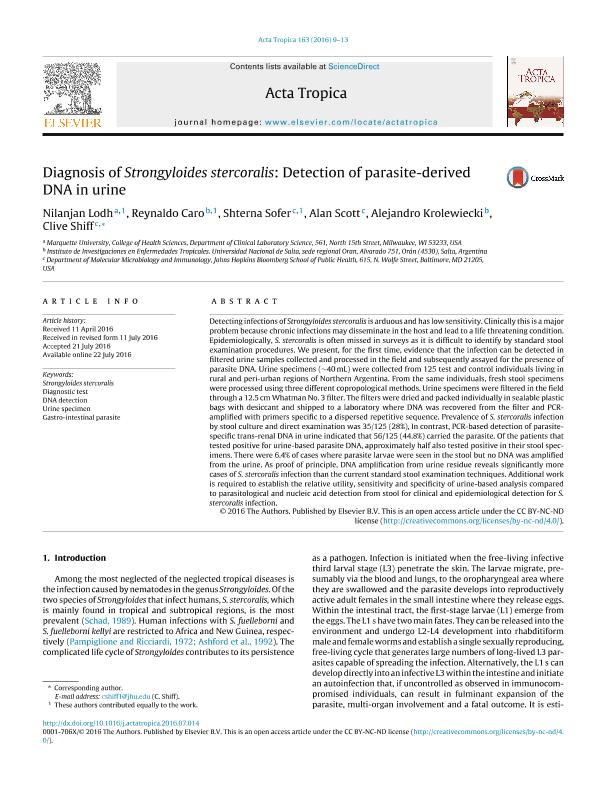Mostrar el registro sencillo del ítem
dc.contributor.author
Lodh, Nilanjan
dc.contributor.author
Caro, Reynaldo
dc.contributor.author
Sofer, Shterna
dc.contributor.author
Scott, Alan
dc.contributor.author
Krolewiecki, Alejandro Javier

dc.contributor.author
Shiff, Clive
dc.date.available
2017-12-07T15:20:14Z
dc.date.issued
2016-07
dc.identifier.citation
Lodh, Nilanjan; Caro, Reynaldo; Sofer, Shterna; Scott, Alan; Krolewiecki, Alejandro Javier; et al.; Diagnosis of Strongyloides stercoralis: Detection of parasite-derived DNA in urine; Elsevier Science; Acta Tropica; 163; 7-2016; 9-13
dc.identifier.issn
0001-706X
dc.identifier.uri
http://hdl.handle.net/11336/29934
dc.description.abstract
Detecting infections of Strongyloides stercoralis is arduous and has low sensitivity. Clinically this is a major problem because chronic infections may disseminate in the host and lead to a life threatening condition.Epidemiologically, S. stercoralis is often missed in surveys as it is difficult to identify by standard stool examination procedures. We present, for the first time, evidence that the infection can be detected in filtered urine samples collected and processed in the field and subsequently assayed for the presence of parasite DNA. Urine specimens (∼40 mL) were collected from 125 test and control individuals living in rural and peri-urban regions of Northern Argentina. From the same individuals, fresh stool specimens were processed using three different copropological methods. Urine specimens were filtered in the field through a 12.5 cm Whatman No. 3 filter. The filters were dried and packed individually in sealable plastic bags with desiccant and shipped to a laboratory where DNA was recovered from the filter and PCRamplified with primers specific to a dispersed repetitive sequence. Prevalence of S. stercoralis infectionby stool culture and direct examination was 35/125 (28%), In contrast, PCR-based detection of parasitespecific trans-renal DNA in urine indicated that 56/125 (44.8%) carried the parasite. Of the patients that tested positive for urine-based parasite DNA, approximately half also tested positive in their stool specimens. There were 6.4% of cases where parasite larvae were seen in the stool but no DNA was amplified from the urine. As proof of principle, DNA amplification from urine residue reveals significantly more cases of S. stercoralis infection than the current standard stool examination techniques. Additional work is required to establish the relative utility, sensitivity and specificity of urine-based analysis compared to parasitological and nucleic acid detection from stool for clinical and epidemiological detection for S.stercoralis infection.
dc.format
application/pdf
dc.language.iso
eng
dc.publisher
Elsevier Science

dc.rights
info:eu-repo/semantics/openAccess
dc.rights.uri
https://creativecommons.org/licenses/by-nc-nd/2.5/ar/
dc.subject
Strongyloides Stercoralis
dc.subject
Diagnostics Test
dc.subject
Dna Detection
dc.subject
Urine Specimen
dc.subject
Gastro-Intestinal Parasite
dc.subject.classification
Salud Ocupacional

dc.subject.classification
Ciencias de la Salud

dc.subject.classification
CIENCIAS MÉDICAS Y DE LA SALUD

dc.title
Diagnosis of Strongyloides stercoralis: Detection of parasite-derived DNA in urine
dc.type
info:eu-repo/semantics/article
dc.type
info:ar-repo/semantics/artículo
dc.type
info:eu-repo/semantics/publishedVersion
dc.date.updated
2017-09-01T18:03:50Z
dc.journal.volume
163
dc.journal.pagination
9-13
dc.journal.pais
Países Bajos

dc.journal.ciudad
Ámsterdam
dc.description.fil
Fil: Lodh, Nilanjan. Marquette University; Estados Unidos
dc.description.fil
Fil: Caro, Reynaldo. Universidad Nacional de Salta. Sede Regional Orán. Instituto de Investigación de Enfermedades Tropicales; Argentina
dc.description.fil
Fil: Sofer, Shterna. Johns Hopkins Bloomberg School of Public Health; Estados Unidos
dc.description.fil
Fil: Scott, Alan. Johns Hopkins Bloomberg School of Public Health; Estados Unidos
dc.description.fil
Fil: Krolewiecki, Alejandro Javier. Consejo Nacional de Investigaciones Científicas y Técnicas. Centro Científico Tecnológico Conicet - Salta. Instituto de Patología Experimental. Universidad Nacional de Salta. Facultad de Ciencias de la Salud. Instituto de Patología Experimental; Argentina. Universidad Nacional de Salta. Sede Regional Orán. Instituto de Investigación de Enfermedades Tropicales; Argentina
dc.description.fil
Fil: Shiff, Clive. Johns Hopkins Bloomberg School of Public Health; Estados Unidos
dc.journal.title
Acta Tropica

dc.relation.alternativeid
info:eu-repo/semantics/altIdentifier/doi/http://dx.doi.org/10.1016/j.actatropica.2016.07.014
dc.relation.alternativeid
info:eu-repo/semantics/altIdentifier/url/http://www.sciencedirect.com/science/article/pii/S0020751912001701
dc.relation.alternativeid
info:eu-repo/semantics/altIdentifier/url/https://www.ncbi.nlm.nih.gov/pmc/articles/PMC5117362/
Archivos asociados
